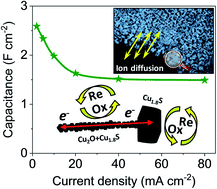A stable and high-energy hybrid supercapacitor using porous Cu2O–Cu1.8S nanowire arrays†
Abstract
A three-dimensional electrode based on porous Cu2O–Cu1.8S nanowires is prepared by means of a facile fabrication process. In this electrode, nanowires are decorated with Cu1.8S polyhedral nanostructures on the top, which are directly grown on a copper foam, thereby eliminating the need for a polymer binder. As an electrochemical electrode, it exhibits an extrinsic pseudocapacitive charge storage mechanism, which is different from that of battery-like Cu2O–CuO and Cu(OH)2 electrodes. The areal and volumetric capacitances of the Cu2O–Cu1.8S electrode can reach 2.6 F cm−2 and ∼200 F cm−3, respectively, at 2 mA cm−2, which are much higher than those obtained using copper(I, II) oxide and hydroxide phases. An asymmetric hybrid supercapacitor device shows areal and volumetric energy densities of 204.8 μW h cm−2 and ∼2.1 mW h cm−3, respectively, at a power density of 3.1 mW cm−2 with a retention ratio of 55% at 15.5 mW cm−2. Besides, both the Cu2O–Cu1.8S electrode and the asymmetric hybrid supercapacitor device exhibit remarkable long-term cycling stabilities, with the capacitance retention of 91% and 94% after 15 000 cycles at the current densities of 40 and 20 mA cm−2, respectively. The porous copper sulfide phase in the fabricated electrode provides a reservoir of ions close to the surface, reducing the diffusion path lengths of ions into the electroactive solid network; this induces an improved electrochemical pseudocapacitive behavior. Our findings shed light on the role of surface modification for creating stable energy storage devices and present a simple way using cost-effective materials to generate more accessible active sites for charge storage on nanostructured electrodes.



 Please wait while we load your content...
Please wait while we load your content...